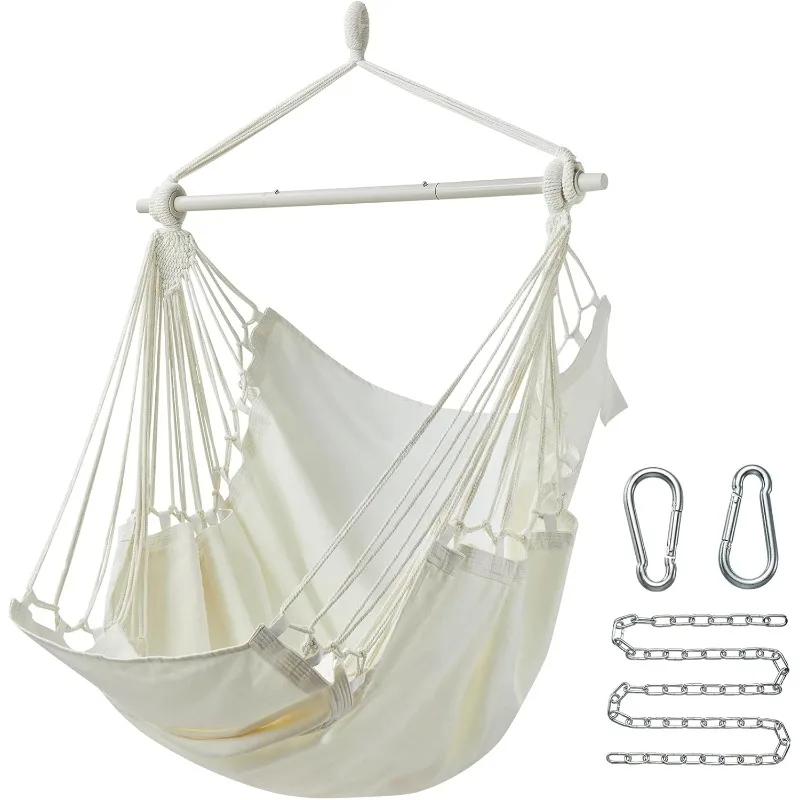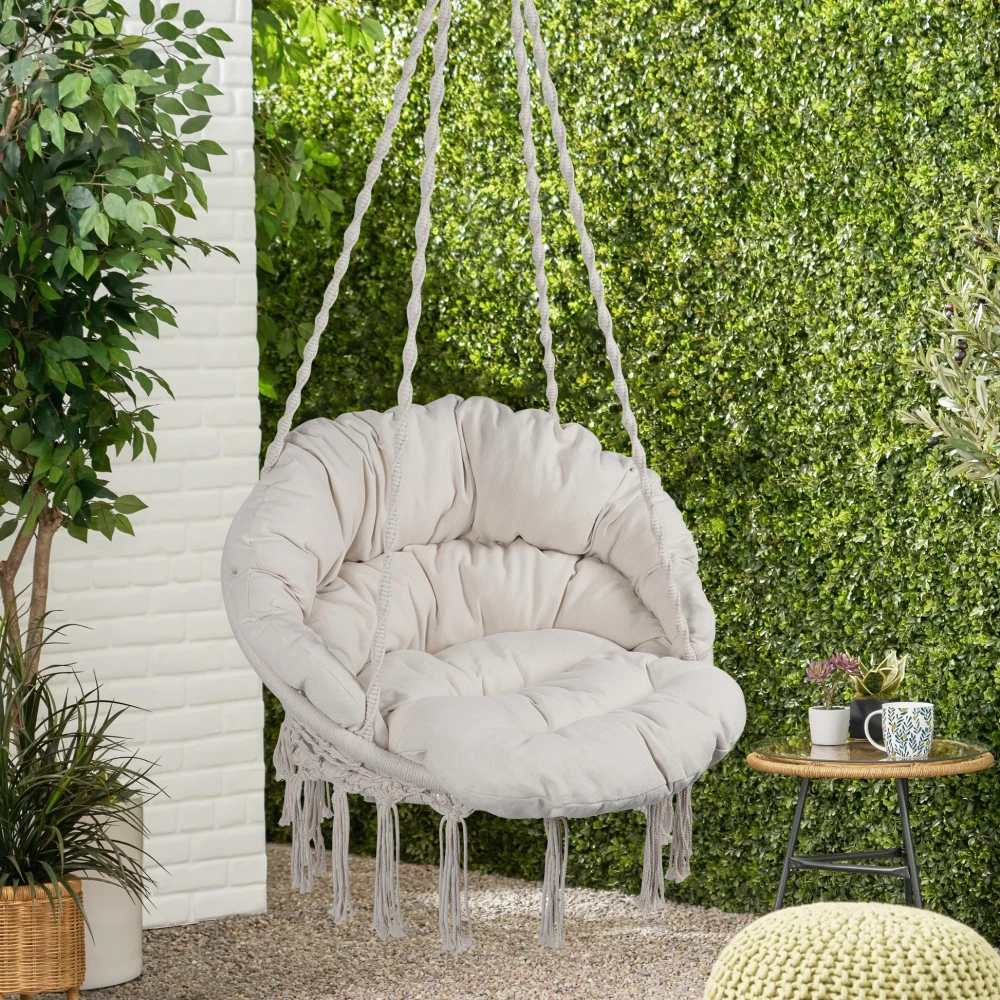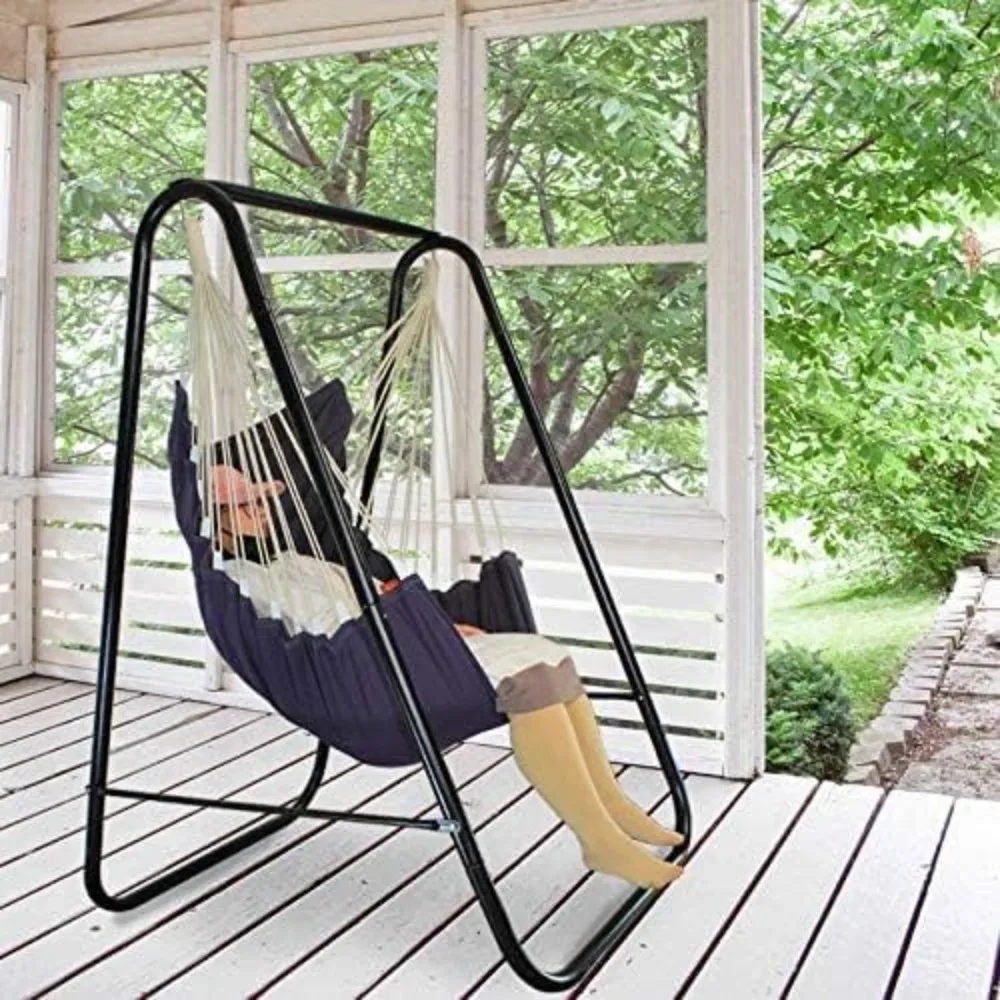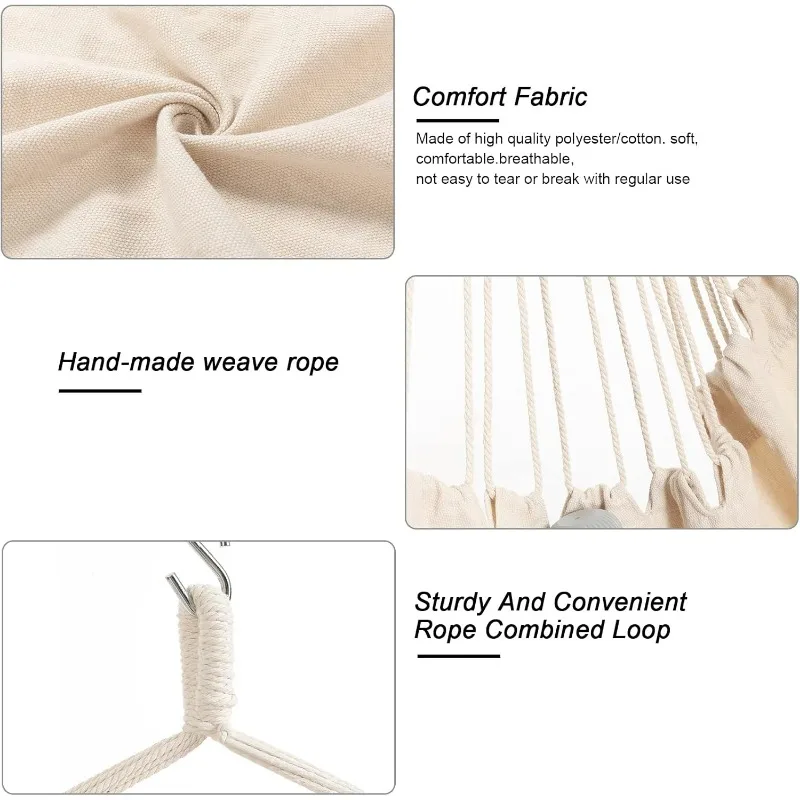The Mental and Emotional Benefits of Porch Swinging
There’s something almost magical about the gentle back-and-forth motion of a porch swing that seems to melt away the stresses of daily life. This isn’t just a pleasant sensation—it’s actually your body responding positively to rhythmic movement in ways that benefit your mental health.
The gentle rocking motion of porch swing hammocks creates a predictable rhythm that helps calm an overactive mind. This rhythmic swinging actually triggers your brain to slow down its activity patterns, similar to what happens during meditation. Research has shown that this kind of repetitive motion can decrease the production of stress hormones like cortisol, allowing your body to enter a more relaxed state.
When you swing, your brain responds by:
- Releasing endorphins, your body’s natural mood elevators
- Decreasing activity in areas associated with anxiety
- Activating the parasympathetic nervous system (your body’s “rest and digest” mode)
- Promoting mindfulness by anchoring you to the present moment
Studies examining vestibular stimulation (the gentle movement that affects your inner ear) show it can significantly enhance mood and reduce symptoms of stress. This science explains why many people intuitively seek out the comfort of a swing when feeling overwhelmed.
Beyond the physiological benefits, there’s also a powerful emotional component to porch swinging. For many, it evokes fond childhood memories or creates a sense of nostalgia that provides emotional comfort. This connection between ultimate relaxation and porch swings runs deep in many cultures, making the experience both physically calming and emotionally nurturing.
Stress Reduction and Anxiety Relief
When stress builds up, your body enters “fight or flight” mode—an ancient survival response that’s often triggered unnecessarily in modern life. The rhythmic motion of swinging effectively interrupts this cycle by sending contradictory signals to your brain: “You’re moving, but you’re also completely safe.”
This peculiar combination helps reset your nervous system. Studies show that rocking motions can reduce cortisol levels by up to 30% during a swinging session, while simultaneously increasing production of mood-stabilizing neurochemicals.
I remember visiting my grandmother who would always retreat to her porch swing after particularly challenging days. “Ten minutes here,” she’d say, “clears my mind better than an hour of worrying.” Science now confirms what she intuitively knew—the gentle, predictable motion provides a sensory experience that effectively distracts from anxious thoughts.
The added benefit of being outdoors compounds these effects. Natural light exposure while swinging helps regulate your circadian rhythm, which further contributes to spine-friendly hammock relaxation and stress reduction. The combination of fresh air, natural scenery, and gentle movement creates a multi-sensory experience that’s particularly effective at calming an anxious mind.
Mood Enhancement and Emotional Regulation
The mood-boosting effects of regular porch swinging go beyond simple stress reduction. The pleasant sensation triggers the release of endorphins—natural compounds that create feelings of well-being and even mild euphoria. This neurochemical response explains why many people report feeling notably happier after spending time on a swing.
Additionally, the dopamine reward system in your brain responds positively to enjoyable, rhythmic activities. This is the same system that makes other pleasurable experiences feel good, creating a natural and healthy way to enhance your mood.
The mood benefits of porch swinging include:
- Increased production of serotonin, especially when swinging outdoors in natural light
- Enhanced emotional regulation through the establishment of rhythmic patterns
- Creation of a predictable comfort ritual that stabilizes mood fluctuations
- Development of a peaceful mental space for processing emotions
Many therapists recognize the value of gentle swinging motion for emotional regulation, particularly for people who struggle with mood disorders or emotional processing difficulties. The combination of gentle movement, comfortable seating, and the opportunity for quiet reflection makes porch swing chair sets particularly valuable tools for emotional wellness.
The Physical Health Benefits of Gentle Swinging Motion
While porch swinging won’t replace your regular workout routine, it does offer surprising physical benefits that contribute to overall wellness. The subtle movements required to keep a porch swing in motion engage multiple muscle groups in a gentle, sustainable way.
Many people underestimate how much physical activity occurs during what seems like a passive experience. When you swing, your body is constantly making minor adjustments to maintain balance and control the swing’s movement. These micro-movements provide a form of gentle, low-impact exercise that’s accessible even to those with mobility limitations.
Physical benefits of regular porch swinging compared to sitting still:
| Activity | Calorie Burn (30 min) | Muscles Engaged | Circulation Impact |
|---|---|---|---|
| Sitting Still | 30-40 calories | Minimal | Low |
| Porch Swinging | 50-70 calories | Core, legs, back | Moderate |
| Walking (slow) | 90-120 calories | Full body | High |
Health experts increasingly recognize the importance of breaking up sedentary time with gentle movement throughout the day. Even these modest increases in physical activity can contribute significantly to overall health, especially for those who may have limitations with more strenuous exercise.
The physical benefits extend to multiple body systems, making proper porch swing hammock installation important for maximizing these health advantages while ensuring safety and optimal positioning.

Vestibular System Stimulation and Balance Improvement
One of the most significant physical benefits of porch swinging is the positive impact on your vestibular system—the sensory system in your inner ear that helps maintain balance and spatial orientation. This complex system plays a crucial role in everyday movements and can weaken without regular stimulation.
The gentle rocking motion of swinging provides ideal, low-intensity stimulation to the vestibular system. This stimulation helps maintain and sometimes improve your sense of balance through:
- Activation of fluid movement in the semicircular canals of the inner ear
- Enhancement of communication between your eyes, inner ear, and brain
- Refinement of proprioception (your body’s awareness of its position in space)
- Strengthening of neural pathways that control balance responses
Research has shown that regular vestibular stimulation can be particularly beneficial for older adults, who naturally experience decline in this system with age. For many seniors, incorporating regular swinging sessions can help maintain balance function and potentially reduce fall risk.
The specific design of swinging hammock chair sets provides an ideal platform for this type of therapeutic motion, allowing for controlled movement that maximizes vestibular benefits without being too intense.
Enhanced Blood Circulation and Gentle Exercise
The rhythmic motion of swinging on a porch swing promotes improved blood circulation throughout your body. Each swinging motion creates subtle shifts in gravity and pressure that help move blood more effectively through your circulatory system.
When you swing, your leg and core muscles engage in a gentle but consistent pattern. These muscles contract and relax rhythmically, creating a pumping effect that helps move blood through your veins back to your heart. This is particularly beneficial for people who spend long periods sitting or standing still during the day.
The circulation benefits include:
- Reduced pooling of blood in the lower extremities
- Decreased swelling in feet and ankles
- Lower risk of circulation-related discomfort
- Gentle muscle engagement that doesn’t strain joints
For individuals with limited mobility or those recovering from injuries, this type of gentle movement provides valuable circulation benefits without putting stress on sensitive joints or muscles. A 30-minute swinging session can burn approximately 50-70 calories—not a rigorous workout, but significantly more active than sitting completely still.
Creating a comfortable porch swing oasis with proper support ensures you can enjoy these circulation benefits for extended periods without discomfort.
Social and Lifestyle Benefits of Porch Swinging
Porch swinging creates a unique social environment that encourages meaningful connection. There’s something about the side-by-side seating arrangement and gentle motion that makes conversations flow more naturally. Unlike face-to-face seating that can sometimes feel confrontational, sitting beside someone on a swing creates a more relaxed atmosphere for sharing thoughts and feelings.
Throughout American history, porch swings have played an important cultural role as gathering spots for families and communities. The front porch swing represents a space between private and public life—a place where neighbors might stop for casual conversation or family members might gather to share stories at day’s end.
Psychologists note that the side-by-side positioning on swings creates what’s called “psychological safety”—people often find it easier to discuss deeper topics when not required to maintain direct eye contact. This makes porch swings particularly valuable for:
- Parent-child conversations about sensitive topics
- Couples working through relationship discussions
- Friends reconnecting after time apart
- Multigenerational family bonding
Communities with active “porch culture” often report stronger social ties and greater neighborhood cohesion. The porch swing serves as what sociologists call a “third place”—somewhere between home and work where community connections form and strengthen.

The spaciousness and comfort of deep seat chair hammock sets make them particularly suitable for these social interactions, providing enough room for comfortable conversation while maintaining the gentle motion that facilitates openness.
The Science Behind Swinging’s Therapeutic Effects
The therapeutic benefits of swinging aren’t just subjective feelings—they’re backed by neurological science. When your body experiences rhythmic swinging motion, several key processes occur in your brain and nervous system.
First, the motion activates your vestibular system in the inner ear, which connects to your brainstem and cerebellum. This stimulation triggers a cascade of neural responses that help regulate arousal levels and promote calming brain wave patterns similar to those seen during meditation.
Perhaps most significantly, swinging stimulates the vagus nerve—the main component of your parasympathetic nervous system responsible for “rest and digest” functions. When activated through gentle, rhythmic motion, the vagus nerve helps:
- Lower heart rate and blood pressure
- Improve digestion
- Reduce inflammation
- Promote feelings of calm and safety
Sensory integration theory in occupational therapy has long recognized the value of swinging motions for neurological organization. This is why swinging is often prescribed as part of therapy for individuals with sensory processing challenges.
From an evolutionary perspective, our positive response to rocking motion likely developed as an adaptive advantage. Infants who were soothed by rocking would cry less, conserve energy, and potentially survive at higher rates—leading to a hardwired response to gentle, rhythmic movement that persists into adulthood.
Various hammock chairs with stands provide different motion patterns that can activate these neurological benefits, allowing users to select the experience that feels most therapeutic for their specific needs.
How to Maximize the Benefits of Your Porch Swing
To get the most health and wellness benefits from your porch swing experience, consider these practical recommendations:
- Optimal duration: 15-30 minutes provides the best balance of benefits without risking motion sensitivity
- Ideal frequency: Daily sessions establish a routine that maximizes cumulative benefits
- Best positioning: Place your swing where you’ll get natural light but with some shade options
- Ergonomic setup: Ensure the swing height allows your feet to touch the ground without straining your back
- Complementary activities: Combine swinging with deep breathing, reading, or meditation to enhance benefits
- Time of day: Early morning swinging helps set a positive tone; evening sessions promote better sleep
- Motion technique: Push gently from your ankles rather than your back to avoid strain
- Posture awareness: Maintain good spinal alignment with appropriate cushioning
Many users find that incorporating mindfulness practices while swinging significantly amplifies the mental health benefits. Simply focusing on the physical sensations—the gentle motion, the touch of the breeze, the support beneath you—can create a meditative experience.
Creating a dedicated routine around your swinging sessions helps establish it as a wellness practice rather than just casual recreation. For example, starting each morning with 15 minutes on your porch swing while enjoying your first cup of coffee creates a ritual that your body and mind begin to recognize and respond to positively.
The right porch swing hammock comfort features can dramatically enhance these benefits by ensuring proper support and minimizing any discomfort that might distract from the experience.
Choosing the Right Porch Swing for Maximum Comfort
The type of porch swing you choose significantly impacts the health benefits you’ll experience. Different materials and designs create distinct experiences that may better suit your specific needs.
| Material | Durability | Comfort Features | Best For |
|---|---|---|---|
| Hardwood | High (10+ years) | Natural give, cool to touch | Traditional settings, classic support |
| Wicker/Rattan | Medium (5-8 years) | Breathable, lightweight | Casual settings, warmer climates |
| Metal Frame with Cushions | High (15+ years) | Customizable comfort, stable | Modern spaces, maximum support |
| Rope/Textile Hammock Swing | Medium (3-6 years) | Body-conforming, gentle motion | Casual relaxation, full-body support |
When selecting a swing for therapeutic benefits, pay special attention to:
- Weight capacity: Choose a swing rated for at least 50 pounds beyond your needs
- Seat depth: Deeper seats (19-22 inches) provide better back support
- Suspension system: Chain systems provide stable movement; rope systems offer more fluid motion
- Weather resistance: Materials that can withstand your local climate without requiring constant maintenance
Safety features are particularly important for therapeutic use. Look for reinforced attachment points, weight-tested chains or ropes, and secure hanging hardware. The installation should be performed according to manufacturer specifications, ideally by a qualified professional for ceiling or beam-mounted options.

The unique design of hanging egg chair sets provides an enclosed feeling that many users find particularly comforting and conducive to deeper relaxation.
Who Can Benefit Most from Regular Porch Swinging?
While almost everyone can enjoy the relaxation of a porch swing, certain groups may experience particularly notable benefits:
Seniors find porch swinging especially valuable for maintaining vestibular health as they age. The gentle motion provides important sensory input that helps preserve balance and coordination without risking falls or injury. Many older adults also appreciate the social aspect of porch swinging, which combats isolation while providing gentle physical activity.
Individuals with anxiety or stress disorders often report significant symptom relief from regular swinging sessions. The rhythmic motion helps interrupt anxiety cycles and provides a predictable sensory experience that can be grounding during periods of heightened stress. Many therapists recommend swinging as part of a comprehensive approach to anxiety management.
Children, particularly those with sensory processing or attention challenges, benefit from the organizing effect swinging has on the developing nervous system. The vestibular stimulation helps improve focus, regulate energy levels, and promote better emotional regulation. Many parents notice improved behavior and attention after swing sessions.
People with sedentary jobs can use porch swinging as a gentle way to counteract the negative effects of prolonged sitting. Even brief swinging breaks provide valuable movement that improves circulation and reduces the musculoskeletal impact of stationary work positions.
Understanding the differences between various relaxation options helps in selecting the most beneficial solution. Comparing swing vs. hammock differences can help determine which option best addresses your specific health needs and space considerations.
Dark Wood Hammock Sets, Porch Swing Chair Sets
$653.82 Select options This product has multiple variants. The options may be chosen on the product pageA-Frame Stand Hammock Sets, Swinging Hammock Chair Sets
$154.62 Select options This product has multiple variants. The options may be chosen on the product pageLight Wood Hammock Sets, Swinging Hammock Chair Sets
$1,359.35 Select options This product has multiple variants. The options may be chosen on the product page- $963.29 Select options This product has multiple variants. The options may be chosen on the product page
Complete Camping Hammock Systems, Hanging Egg Chair Sets
$266.73 Select options This product has multiple variants. The options may be chosen on the product pageDeep Seat Chair Hammock Sets, Hanging Egg Chair Sets
$165.85 Select options This product has multiple variants. The options may be chosen on the product page
Important Considerations and Potential Limitations
While porch swinging offers many benefits, there are some important factors to consider:
Does swinging cause motion sickness for some people?
About 1 in 3 people have some sensitivity to motion. If you experience dizziness or nausea, try shorter sessions with slower movement until your body adapts. Looking at the horizon rather than down at a book can also help reduce motion sensitivity.
What are the weight limitations for typical porch swings?
Most standard porch swings support 450-600 pounds, but always check manufacturer specifications. Exceeding weight limits compromises both safety and therapeutic benefits.
How do weather conditions affect outdoor swings?
Exposure to elements can reduce the lifespan of your swing. Consider weather-resistant materials or bring cushions indoors during inclement weather. Some users prefer indoor-outdoor hanging egg chairs for versatility across seasons.
What space requirements should I consider?
Beyond the swing itself, you need clearance space—typically 3-4 feet in front and behind for proper motion. Ceiling height must accommodate both the swing and suspension system, usually requiring at least 7-8 feet total.
Can everyone safely use a porch swing?
Those with certain inner ear conditions, severe osteoporosis, or specific spinal injuries should consult healthcare providers before regular swinging. Alternative options with less motion might be more appropriate in these cases.
Frequently Asked Questions About Porch Swinging and Health
Is porch swinging considered exercise?
While not aerobic exercise, porch swinging qualifies as light physical activity. It burns 20-30% more calories than sitting completely still and engages core muscles for stabilization.
How long should I swing for health benefits?
Research suggests 15-30 minutes provides optimal benefits. Shorter sessions (5-10 minutes) still offer stress reduction, while longer sessions might lead to diminishing returns or motion sensitivity.
Can porch swinging help with specific health conditions?
Regular swinging shows promise for anxiety reduction, mild depression management, and sensory processing challenges. It may also help with certain types of chronic pain by promoting relaxation and gentle movement.
Is indoor or outdoor swinging better for health?
Outdoor swinging offers added benefits of fresh air and natural light exposure. However, indoor options provide consistency regardless of weather and can be equally beneficial for vestibular stimulation.
How does porch swinging compare to rocking chairs?
Both provide rhythmic motion, but swings create more pronounced vestibular stimulation due to their greater range of movement. Rocking chairs engage leg muscles more actively, while swings better promote total-body relaxation.
Comparing Porch Swings to Other Relaxation Methods
When considering various relaxation techniques, porch swinging offers a unique combination of benefits:
| Relaxation Method | Physical Benefits | Mental Benefits | Accessibility | Cost Effectiveness |
|---|---|---|---|---|
| Porch Swinging | Moderate (vestibular, gentle movement) | High (stress reduction, mood enhancement) | High | High (one-time investment) |
| Meditation | Low (minimal movement) | Very High (stress reduction, mindfulness) | Very High | Very High (free) |
| Reading | Low (minimal movement) | Moderate (cognitive distraction) | High | High (library access) |
| Walking | High (cardiovascular, muscular) | Moderate (stress reduction) | High | Very High (free) |
| Massage | High (muscular, circulation) | High (stress reduction) | Low | Low (ongoing cost) |
Porch swinging stands out for its balanced combination of physical and mental benefits without requiring special skills or ongoing costs. It’s particularly valuable because it provides vestibular stimulation not found in most other relaxation methods.
Many users find that combining swinging with other techniques multiplies the benefits—such as reading while swinging or practicing deep breathing exercises during swinging sessions. This complementary approach creates a more comprehensive wellness experience than any single method alone.
Is Porch Swinging Good for You? The Verdict
After examining the evidence, the answer is clear: yes, porch swinging offers substantial health benefits for most people. The unique combination of gentle movement, rhythmic stimulation, and comfortable positioning creates a wellness experience that addresses multiple dimensions of health simultaneously.
The mental health benefits alone—stress reduction, improved mood, and anxiety relief—would make porch swinging worthwhile. When combined with the physical benefits of improved circulation, vestibular stimulation, and gentle muscle engagement, it becomes an exceptionally well-rounded wellness activity.
While not a replacement for regular exercise or medical treatment, incorporating regular porch swinging into your routine provides a simple, accessible way to enhance overall wellbeing. The minimal investment in a quality swing yields ongoing returns in the form of better physical, mental, and social health.
For those seeking an effective way to reduce stress and improve wellness without adding another demanding activity to their schedule, regular porch swinging offers an evidence-based solution that’s as enjoyable as it is beneficial.







